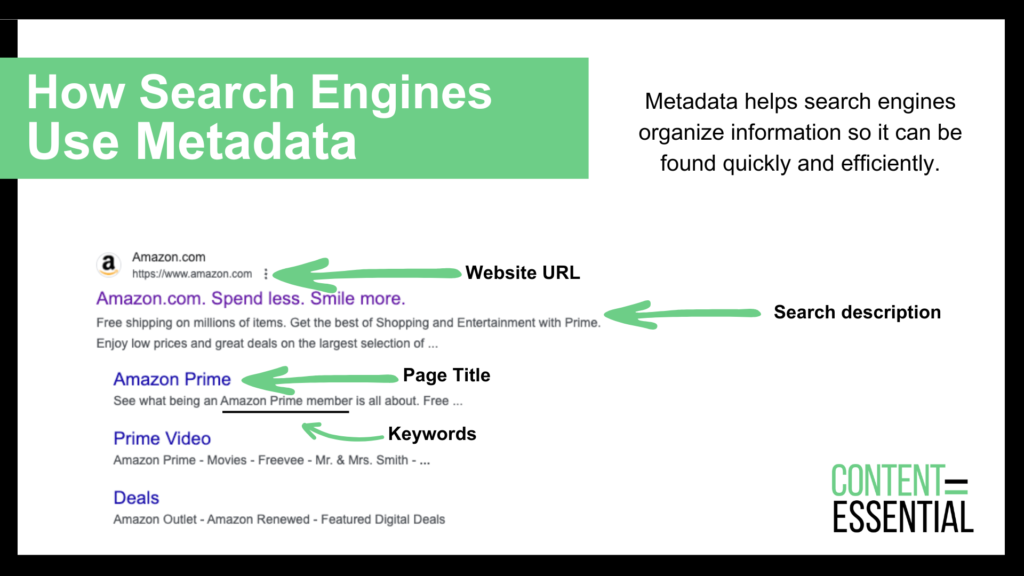Metadata is one of the most important components of your organization’s information architecture but is often left underdeveloped or omitted completely.
The lack of well-documented metadata can prove a major obstacle to a pain-free content audit, inventory or website migration project. Marketers and business owners need to make metadata entry a priority as part of the content development process.
What is Metadata?
Metadata is the descriptive information for different forms of content. It is critical for an effective search engine optimization (SEO) strategy and helps your audience find your organization, products, and services more easily when they look for it in places like Google or your website’s search function. There are two types of metadata: website and content.

Website Metadata
Website metadata is best described as the “back-end” information that helps users locate published information when searching on a website. Types of website metadata include:
- URL
- Page title
- Search description
- Keywords
- File name
The URL
URL stands for Uniform Resource Locator (bet you didn’t know that, did you?). Every computer or device is identified via an IP, or Internet Protocol, address., a unique identifier that points to a specific computer. Rather than having to use an IP address whenever you want to locate a computer or web page, URLs were invented. The URL is composed of the protocol (http), the host/domain name (www.yourwebsite.com) and the file name (teddy-bear-collection).
Page Title
The page title tag appears at the top of the browser window. When you open different browsers or tabs, the name of the page – the title – appears. Best practice is to have a page title tag that is short enough to be seen but one that also adequately and accurately describes the page being seen. It also appears on search engine pages.
Search Description
When Google or other search engines crawl and index website pages, it pulls the description for users. The description should give a short, concise summary about the website.
Keywords
Keyword tags are five to 10 relevant words or phrases that refer to the content on the website page. Typically, they are words that audiences would commonly use when searching online for something so they should actually appear in the content one the website page. For example, if your website page is about guitar lessons, then a few keywords may be “guitar, guitar lessons, music, music lessons, acoustic guitar, acoustic guitar lessons, electric guitar, electric guitar lessons.”
File Name
The concept of file names is often a little difficult for some organizations and marketers to grasp. When a content item is created, a naming convention should be assigned that aids in tracking and organization. In newsrooms, that naming convention is referred to as a “slug” but on the business side, it may just be called a file name. Naming conventions should be consistent to make content retrieval easier.
Examples of a file names for an article on teddy bears, for example, could be:
/where-to-buy-a-vintage-teddy-bear-02232018-article
/where-to-buy-a-vintage-teddy-bear-02242018-video
/where-to-buy-a-vintage-teddy-bear-02252018-infographic
In the URL, the file name appears behind the domain name or at the end of the breadcrumb. For example, it may look like this:
www.vintagebears.com/where-to-buy-a-vintage-teddy-bear-02232018-article
It gives you a lot of information about the content item – what the file name is, the date it was published and the type of content.
Content Metadata
Content metadata is a little easier to understand. It is all the information that describes a content item. Content metadata helps determine the taxonomy, or organizational structure of the content items. Think taxonomy as buckets. You’re using buckets to determine the who, what, where, why and when for your content item.
Basic content metadata includes:
- File name
- Author
- Date created
- Date published
- Keywords
- Content item type
- Category
Having this information makes it easier to retrieve it at a later time or to perform strategic analysis based on specific parameters. A content manager, marketer or business owner may want to conduct a filtered search based on a set of metadata-based factors. For example, he or she may want to know how many articles were published in January 2023 by a specific writer using particular keywords.
The practice of properly and consistently tagging content with the appropriate metadata will provide strategic intelligence in addition to SEO such as data analytics and, potentially, insights into revenue projections.
For example, perhaps a published article touts the benefits of a new road bike and is linked to an ecommerce site where it was being sold. It is possible to use the article’s metadata to determine how many customers were engaged enough to buy the bike and how much revenue was generated. Metadata can help answer the question of whether the company received a return on its investment for producing the article.
While some organizations consider metadata as an afterthought when it comes to the content it produces, it has the ability to provide important business insights.